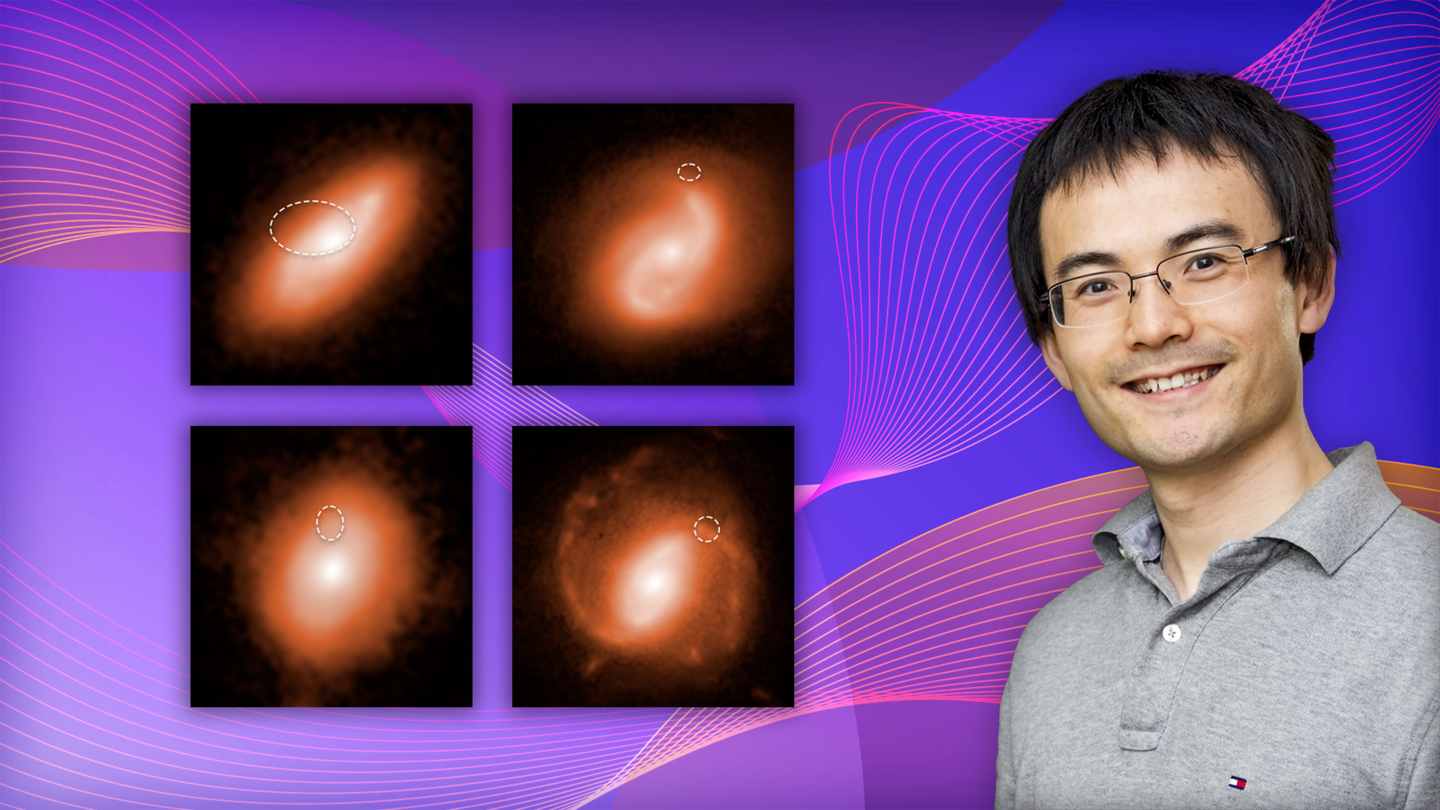Reviewed by Alex SmithMay 23 2022
Fast radio bursts are one of the most perplexing occurrences in the universe, releasing as much energy in a second as the Sun does in a year.
 Physicist Kenan Qu with images of fast radio burst in two galaxies. Top and bottom photos at left show the galaxies, with digitally enhanced photos shown at the right. Dotted oval lines mark burst locations in the galaxies. Image Credit: Qu photo by Elle Starkman; galaxy photos courtesy of NASA; collage by Kiran Sudarsanan.
Physicist Kenan Qu with images of fast radio burst in two galaxies. Top and bottom photos at left show the galaxies, with digitally enhanced photos shown at the right. Dotted oval lines mark burst locations in the galaxies. Image Credit: Qu photo by Elle Starkman; galaxy photos courtesy of NASA; collage by Kiran Sudarsanan.
The Princeton Plasma Physics Laboratory (PPPL) of the Department of Energy and the SLAC National Accelerator Laboratory have designed and proposed a cost-effective experiment to generate and observe the early stages of this process in a way that was previously thought to be impossible with current technology.
Celestial bodies such as neutron stars or collapsed stars known as magnetars (magnet + star) are responsible for the remarkable blasts in space. According to quantum electrodynamic (QED) theory, these fields are so intense that they convert space’s vacuum into an exotic plasma made up of matter and anti-matter in pairs of negatively charged electrons and positively charged positrons. The intense rapid radio bursts are thought to be caused by emissions from these pairings.
Pair Plasma
The matter-antimatter plasma, known as “pair plasma,” differs from the typical plasma that supports fusion processes and accounts for 99% of the observable universe. This plasma is made up entirely of electrons and much more massive atomic nuclei or ions. The electron-positron plasmas are made up of particles of equal mass but oppositely charged charges that can annihilate and create each other. These plasmas can have a wide range of collective behavior.
Our laboratory simulation is a small-scale analog of a magnetar environment. This allows us to analyze QED pair plasmas.
Kenan Qu, Study First Author and Physicist, Department of Astrophysical Sciences, Princeton University
Qu is the initial author of a work that was featured as a Scilight in Physics of Plasmas, as well as the first author of an article in Physical Review Letters that the current paper builds on.
“Rather than simulating a strong magnetic field, we use a strong laser. It converts energy into pair plasma through what are called QED cascades. The pair plasma then shifts the laser pulse to a higher frequency. The exciting result demonstrates the prospects for creating and observing QED pair plasma in laboratories and enabling experiments to verify theories about fast radio bursts,” added Qu.
According to physicist Nat Fisch, a professor of astrophysical sciences at Princeton University and assistant director for academic affairs at PPPL, who acts as the principal investigator for this study, laboratory-produced pair plasmas have previously been constructed.
“And we think we know what laws govern their collective behavior. But until we actually produce a pair plasma in the laboratory that exhibits collective phenomena that we can probe, we cannot be absolutely sure of that,” Fisch explained.
Collective Behavior
The problem is that collective behavior in pair plasmas is notoriously hard to observe. Thus, a major step for us was to think of this as a joint production-observation problem, recognizing that a great method of observation relaxes the conditions on what must be produced and in turn leads us to a more practicable user facility.
Prof. Nathaniel J. Fisch, Study Principal Investigator and Physicist, Astrophysical Sciences, Princeton University
By interacting the laser with a concentrated electron beam traveling near the speed of light, the research suggests a novel simulation that produces high-density QED pair plasma. When compared to the generally proposed method of colliding ultra-strong lasers to create QED cascades, this approach is more cost-effective. The method also slows plasma particle movement, allowing for greater collective effects.
“No lasers are strong enough to achieve this today and building them could cost billions of dollars. Our approach strongly supports using an electron beam accelerator and a moderately strong laser to achieve QED pair plasma. The implication of our study is that supporting this approach could save a lot of money,” Qu noted.
Preparations are already underway at SLAC for a new round of laser and electron tests to evaluate the simulation.
In a sense what we are doing here is the starting point of the cascade that produces radio bursts.
Sebastian Meuren, Study Co-Author, SLAC Researcher, and Former Postdoctoral Visiting Fellow, Princeton University
Evolving Experiment
“If we could observe something like a radio burst in the laboratory that would be extremely exciting. But the first part is just to observe the scattering of the electron beams and once we do that we’ll improve the laser intensity to get to higher densities to actually see the electron-positron pairs. The idea is that our experiment will evolve over the next two years or so,” stated Meuren.
The overall purpose of this study, according to Qu, is to figure out how bodies like magnetars form pair plasma and what new physics are created as a result of rapid radio bursts. Qu also added, “These are the central questions we are interested in.”
This collaboration was made possible by National Nuclear Security Agency (NNSA) funding to Princeton University’s Department of Astrophysical Sciences and DOE grants to Stanford University.
Journal Reference:
Qu, K., et al. (2022) Collective plasma effects of electron–positron pairs in beam-driven QED cascades. Physics of Plasmas. doi.org/10.1063/5.0078969.